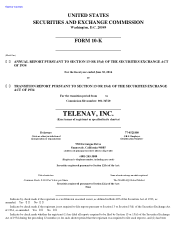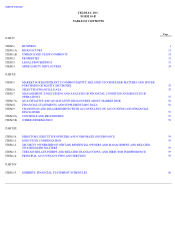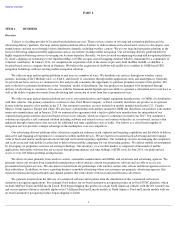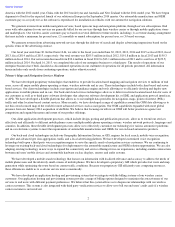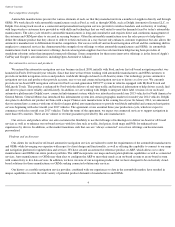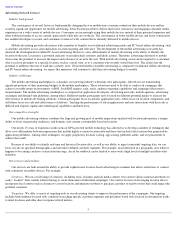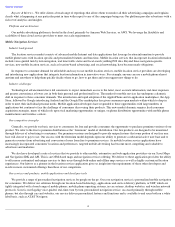TeleNav 2014 Annual Report Download - page 10
Download and view the complete annual report
Please find page 10 of the 2014 TeleNav annual report below. You can navigate through the pages in the report by either clicking on the pages listed below, or by using the keyword search tool below to find specific information within the annual report.
Table of Contents
Advertising Network Services
Industry background
The convergence of several factors is fundamentally changing the way mobile users consume content on their mobile devices and has
created a significant opportunity for mobile advertising. It has become possible to deliver innovative, interactive and engaging consumer media
experiences on a wide variety of mobile devices. Consumers are increasingly using their mobile devices instead of their personal computers and
other traditional media to access content, particularly while they are on the go. The convergence of better mobile devices and faster connectivity
has enabled developers to create, and consumers to interact with, content that is instantly delivered to mobile devices.
Mobile advertising provides advertisers with a number of benefits over traditional advertising media and PC-
based online advertising, such
as anytime, anywhere access, personalization, location targeting and relevance. The development of the mobile advertising ecosystem has
mirrored the development for online PC-based advertising. However, a key differentiator of mobile advertising is the ability to identify the
location of the user. Location is a powerful indicator of an individual's interests and likely actions. Therefore, advertising delivered to mobile
devices has the potential to increase the impact and relevance of an ad to the user. With mobile advertising, an ad can be targeted to a consumer
who is in close proximity to a specific location, such as a retail store, or to a consumer who recently visited that store. The ad also has the
potential to influence the user to walk into a nearby store. Given the benefits of mobile advertising as compared to traditional offline advertising
and PC-based online advertising, we expect that marketers will continue to shift their advertising budgets to mobile.
Industry challenges
The mobile advertising marketplace is a dynamic, fast growing industry with many new participants. Advertisers are transitioning
significant portions of their marketing budgets to the mobile marketplace. These advertisers need to be able to conduct ad campaigns that
achieve favorable return on investment, or ROI. Such ROI requires scale, reach, audience targeting capabilities and campaign effectiveness
measurements. The mobile advertising marketplace is comprised of application developers, advertising networks, mobile agencies, advertising
exchanges and demand-side platforms, among others. Different market participants have focused on different potential means to increase the
effectiveness of mobile advertising solutions. Certain participants focus on specific application users, others focus on location components, and
still others focus on scale and effectiveness of delivery. Tracking the performance of ads in applications and user interactions with those ads is
difficult and requires significant technological capabilities and know-how.
Our competitive strengths
Our mobile advertising solution combines the large and growing pool of mobile impressions marked with location information, a unique
ability to focus on particular audiences, and dynamic user content customizable based on location.
Our nearly 15 years of experience in the arena of GPS-powered mobile technology has allowed us to develop a number of techniques that
allow us to differentiate between impressions that include highly-accurate location data and those that include false location data generated by
application publishers. Among other techniques, we apply proprietary location scoring, app scoring, publisher audits, and test placements to
achieve this result.
Because of our ability to identify real-time and historical location data, as well as our ability to ingest contextual targeting data, we can
focus our ads on specified demographics and advertiser defined customer segments. For example, an ad delivered in a geographic area where it
happens to be raining can have a rain-related message. An ad for sunblock can be limited to areas with a high level of sunlight and ultraviolet
radiation.
Our services and products
Our services are built around the ability to provide sophisticated location-based advertising in a manner that allows advertisers to connect
with consumers on mobile devices. For example:
Creatives - We run a wide range of creatives, including static, dynamic and rich media content. Our creative allows national advertisers to
easily “localize” their content without having to create thousands of individual campaigns. Our creative focuses on leveraging location data to
incorporate local context such as distance to a store location, information on where to purchase a product or nearby events that could impact the
potential consumer.
Targeting - We offer a variety of targeting tools to our advertising clients to improve the performance of the campaigns. Our targeting
includes both audience-focused tools centered on reaching specific customer segments and proximity based tools focused on driving foot traffic
to retail locations and other direct-response related metrics.
5


